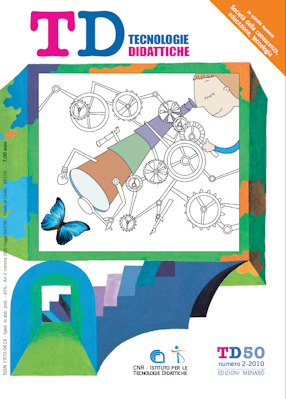Creativity and ICT in compulsory school: a survey of teachers' opinions and practices
Main Article Content
Abstract
Article Details
Authors who publish with this journal agree to the following terms:
- Authors retain copyright and grant the journal right of first publication with the work simultaneously licensed under a Creative Commons CC BY 4.0 Attribution 4.0 International License.
- Authors are able to enter into separate, additional contractual arrangements for the non-exclusive distribution of the journal's published version of the work (e.g., post it to an institutional repository or publish it in a book), with an acknowledgement of its initial publication in this journal.
- Authors are permitted and encouraged to post their work online (e.g., in institutional repositories or on their website) prior to and during the submission process, as it can lead to productive exchanges, as well as earlier and greater citation of published work (See The Effect of Open Access)
References
Amabile T. M. (1989). Growing Up Creative. New York: Crown Publishing Group, Inc.
Banaji S., Burn A., Buckingham D. (2006). Rhetorics of creativity: a review of the literature, URL: http://www.creative-partnerships.com/data/files/rhetorics-ofcreativity-12.pdf (ultima consultazione 02 luglio 2010).
Beghetto R. A. (2005). Does Assessment Kill Student Creativity? The Educational Forum, 69, pp. 254–263.
Black P., Harrison C., Lee C., Marshall B., William D. (2004). Working Inside the Black Box: assessment for learning in the classroom. Phi Delta Kappan, 86(1), pp. 9-21.
Boden M. (2001). Creativity and Knowledge. In A. Craft, B. Jeffrey e M. Leibling (eds.). Creativity in education. London: Continuum, pp. 95-102.
Craft A. (2005). Creativity in schools: tensions and dilemmas. London: Routledge.
EC (2009). Ambasciatori europei per la Creatività e l’Innovazione - Manifesto, URL: http://ec.europa.eu/education/lifelong-learning-policy/doc/year09/manifesto_it.pdf (ultima consultazione 28 giugno 2010).
EC (2010). Una strategia per una crescita intelligente, sostenibile e inclusiva. Comunicazione della Commissione Europa 2020, URL: http://ec.europa.eu/eu2020/pdf/COMPLET%20IT%20BARROSO%20-%20Europe%202020%20-%20IT%20version.pdf (ultima consultazione 28 giugno 2010).
Ellis S., Barrs M. (2008). The Assessment of Creative Learning. In J. SeftonGreen (ed.). Creative Learning. London: Creative Partnerships, pp. 73-89.
Esquivel G. B. (1995). Teacher behaviors that foster creativity. Educational Psychology Review, 7(2), pp. 185-202.
Ferrari A., Cachia R., Punie Y. (2009). Innovation and creativity in education and training in the EU Member States: fostering creative learning and supporting innovative teaching. Literature review on Innovation and Creativity in E&T in the EU Member States (ICEAC), Technical Note: JRC 52374, URL: http://ftp.jrc.es/EURdoc/JRC52374_TN.pdf (ultima consultazione 02 luglio 2010).
Hargreaves D. (2003). Education Epidemic. Transforming secondary schools through innovation networks. Demos, URL: http://www.demos.co.uk/publications//educationepidemic (ultima consultazione 28 giugno 2010).
Lindström L. (2006). Creativity: What Is It? Can You Assess It? Can It Be Taught?. The International Journal of Art & Design Education, 25(1), pp. 53-66.
Loveless A. M. (2002). Literature Review in Creativity, New Technologies and Learning. Bristol, UK: Futurlab, URL: http://www.futurelab.org.uk/resources/documents/lit_reviews/ Creativity_Review.pdf (ultima consultazione 0 2luglio 2010).
Loveless A. M. (2007). Creativity, technology and learning – a review of recent literature, 4 (update). Bristol, UK: Futurlab, URL: http://www.futurelab.org.uk/resources/documents/lit_reviews/Creativity_Review_update.pdf (ultima consultazione 02 luglio 2010).
NACCCE (1999). All our futures: Creativity, culture and education. Sudbury: National Advisory Committee on Creative and Cultural Education, DfEE e DCMS, URL: http://www.cypni.org.uk/downloads/alloutfutures.pdf (ultima consultazione 02 luglio 2010).
Piaget J. (1973). To understand is to invent: the future of education. New York: Grossman Publishers.
Prensky M. (2004). What can you learn from a cell phone? Almost anything!. Innovate Journal of Online Education, URL: http://innovateonline.info/pdf/vol1_issue5/What_Can_You_Learn_from_a_Cell_Phone__Almost_Anything!.pdf (consultazione 28 giugno 2010).
Punie Y., Cabrera M., Bogdanowicz M., Zinnbauer D., Navajas E. (2005). The future of ICT and learning in the knowledge society. Institute for Prospective Technological Studies (IPTS), Joint Research Centre, European Commission, URL: http://ftp.jrc.es/EURdoc/eur22218en.pdf (ultima consultazione 28 giugno 2010).
Robinson K. (2001). Out of our minds: learning to be creative. Oxford: Capstone.
Runco M. A. (1999). Implicit Theories. In M. A. Runco e S. R. Pritzker (eds.). Encyclopedia of creativity, 2. San Diego, California; London: Academic, pp. 27-30.
Runco M. A. (2003). Education for Creative Potential. Scandinavian Journal of Educational Research, 47(3), pp. 317-324.
Sawyer R. K. (2006). Explaining creativity: The science of human innovation. Oxford University Press, USA.
Scanlon M., Buckingham D., Burn A. (2005). Motivating maths? Digital games and mathematical learning. Technology, Pedagogy and Education, 14(1), pp. 127-139.
Vygotsky L. S. (2004). Imagination and creativity in childhood. Journal of Russian and East European Psychology, 42(1), pp. 7-97.

